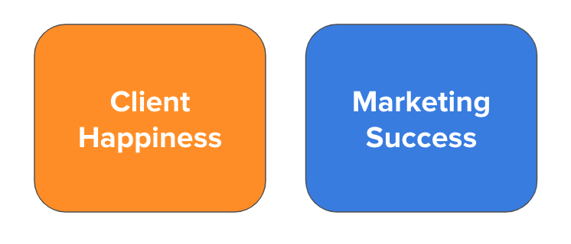The Formula for Client Success in Higher Education Marketing

November 12, 2020

I was recently prepping for our agency’s Dev Days – an action-packed two-day event in which we put client work on pause to focus solely on our growth and development as marketing professionals. This time allows us to connect with other team members we don’t work with frequently to pick their brains, get new ideas, and build camaraderie through collaborative sessions and open discussions.
I was crafting a workshop on "Client Success vs. Client Happiness" but was having a tough time wrapping my brain around the difference between the two. By the end of the day, I had determined that client success was based on how great the results were while client happiness was about how much the client liked us.
The next day, I began the session and was joined by a very special guest who was visiting our office for the first time: Guillaume Delloue, our Principal Channel Consultant at HubSpot and all-around fantastic human being. If I’m being frank, I was now quite nervous, thinking, “this guy works with the best of the best, what am I going to teach him?”
As I kicked off the session, Guillaume interjects to ask what the difference is between client success and client happiness as I was drawing a T-chart trying to show the components of each. His question wasn’t accusatory, it was one of curiosity, which greatly settled my nerves.
At this point, we broke into an open discussion among the whole group of team members as we tried to determine what actually gets clients to fall in love with DD from top to bottom.
We discovered that client success is NOT one of the factors of the equation, it’s the solution – the end goal. We then worked together to identify all of the elements that lead to client success, and found that they fell into two main categories:

What is Client Happiness?
What makes a client happy? Well, they have to be happy with everything we’re doing, saying, and producing. *Pressure has entered the chat*
If a client doesn’t understand why we’re doing something or where the value will come from, it doesn’t matter how great the asset may be, client happiness will not be achieved.
If we don’t establish clear expectations, communicate well, and bring the feeling of passion and joy into our work, client happiness will not be achieved.
If the work we’re creating isn’t wowing our clients, providing them with a sense of relief and comfort, and making their lives easier, client happiness will not be achieved.
So, then, what does it take to keep a client happy? It takes confident, passionate, and caring team members who treat each client like they work in the office right next door to theirs — and that’s what we’re constantly striving for at DD.
Client happiness is really about service and partnership. The client needs to feel very well served by the marketing team, and they need to feel like we have their back when they're facing challenges and need more help.
Happiness can come in many different forms, though, and it really depends on what the client wants from us. Are they looking for a high volume of execution, strategic leadership, deeper insights into their numbers, all of the above? Our goal is to deliver what you need, what you want, and then some.
We don’t just want to build marketing assets; we want to build relationships.
So much of typical agency work these days is transactional and based on one of the following premises: 1) what can we do for you with the minimum amount of effort while charging you at the highest rate? or 2) how can we build a model that is 100% scalable and allows us to rinse and repeat as much as possible? Both of these approaches are agency-centered and don’t usually lead to true client happiness. We’re not about that.
Client happiness won’t transform into client success on its own — we love happy clients, but if the actual performance of the marketing efforts aren’t impressive, we’re really only halfway to achieving true client success.
What About Marketing Performance?
The second part of this formula is just as important as the first, and arguably much more challenging. You hired us to improve your student recruitment efforts and if the marketing strategies and tactics we're operating aren’t delivering measurably positive results, then you don't have great marketing performance.
We use a very powerful marketing platform (HubSpot) to build and deliver the marketing assets we create, which allows us to measure everything from page views to enrolled students. We pride ourselves on tracking the effectiveness of our marketing campaigns from top-to-bottom of the funnel!
I can’t tell you the number of times I’ve seen reports from other digital marketing agencies that cover impressions, clicks, click-through rate, and cost-per-click, and nothing more – we call these “vanity metrics.” They make you feel good at the top, but they tell you nothing about the middle or the bottom of the funnel. Who is that helping?
Marketing's job is not just getting prospects to your website — it’s the full experience from first-touch to the end goal (and everywhere in between!). If you can’t see how many of those clicks turned into actual emails acquired, inquiries submitted, or applications started, then what was the point of even running that digital ad campaign? In everything we produce, we’re thinking about the entire applicant journey and how it can be tracked and recorded.
If you can't track your marketing, you'll never know if the performance is great.
What we develop for each of our clients are the actual marketing baselines from page views down to enrolled students. Here are the real metrics that matter and what you should be tracking at the highest level:
- Page Views
- Form Submissions
- New Contacts (out of total submissions)
- Inquiries
- Applicants
- Enrolled Students
There are many more detailed metrics we could get into like ad spend, cost-per-new-contact, cost per-accepted student, and so on, but this is the bare minimum you need to efficiently recruit students these days.
What we do to ensure great marketing performance is track all of the assets individually, ranging from one digital ad to an entire email communication flow. You might be thinking “Cool, but that sounds a lot like the tool is doing all the work for you” and you’re not too far off. Where we come in after we launch all these assets is the A/B testing, constant data monitoring + analysis, and strategic recommendations of what we think is best to do next given what the data is telling us.
The work of interpreting the data is the most important job of any marketing team.
We’re huge proponents of letting the data do the talking and not creating assets because “we did this last year” as many tend to do for the sake of time or out of fear of trying something new. This constant evolution of micro-strategic improvements builds a healthier and higher-performing library of emails, digital ads, landing pages, blog posts, and/or conversational marketing tactics.
And when you combine high levels of client happiness and great marketing performance you end up with…
The Formula for Client Success
The goal of every agency should be to achieve client success by delivering fantastic client happiness combined with high-performing enrollment marketing campaigns. When both are achieved at high levels, the outcome becomes mutually beneficial and strengthens the relationship to a level of complete trust and transparency, minimizing the skepticism that exists in some working relationships between marketing agencies and higher ed teams.

Because you can have a happy client with poor marketing performance, and the client isn't really successful at the end of the day. And conversely, you can have amazing marketing performance that beats all of the competition, but with an unhappy client, that's going to be a one-hit wonder.
Curious what client success looks like for you? Book a meeting with me so we can chat!
Find Out the Freshest Industry Benchmarks
Do you know how prospective students are engaging with email? How are virtual events affecting recruitment? Are you considering all three prospective student stages when creating content? Look no further! See how your institution stacks up against other schools across these primary marketing tactics.
Download our free guide, DD’s Deep Dive: Enrollment Marketing Benchmarks Report to learn:
- Benchmark data for four primary marketing tactics: event marketing, email marketing, digital advertising, and content marketing
- New behaviors of prospective grad students as they research and journey through the applicant funnel from initial interest to application completion
- Specific insights on which tactics are the most effective in engaging and converting prospects at all stages
.jpg?width=286&height=190&name=sam%20and%20matt%20(1).jpg) EBOOK
EBOOK
See how schools are using HubSpot for their enrollment marketing
Service Categories: Enrollment Marketing, Inbound Marketing










.png)